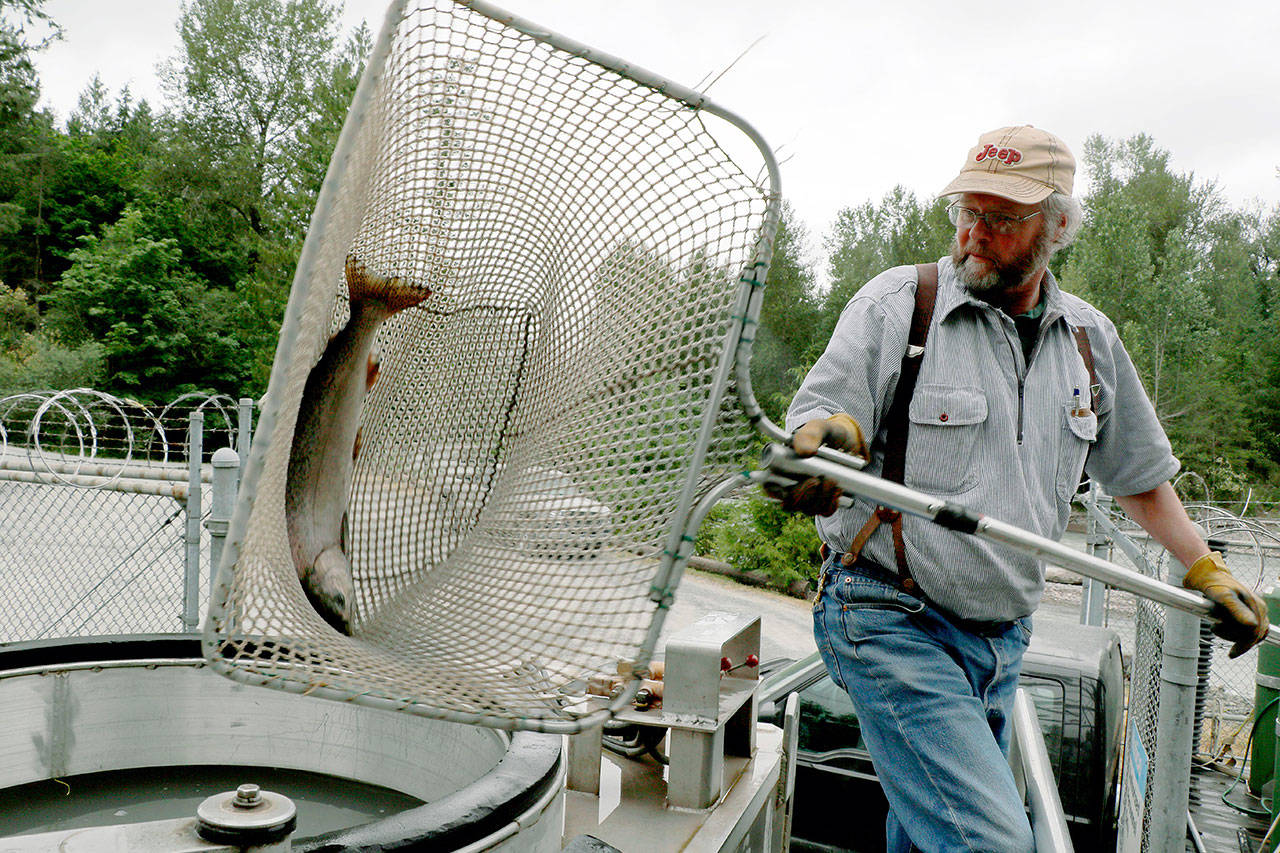The White River’s 2016 Chinook salmon run numbers were the best seen in 71 years until 2017’s run.
Runs consistently averaged 1,565 in the early 2000s, but 2017’s count as of mid-October was 15,565, a 67 percent increase from 2016’s 9,347 total.
With historical lows of only a few dozen 20 years ago, White River Chinook are seemingly rebounding from the collaborative efforts in managing Endangered Species Act-listed fish and designated critical habitat by officials from the U.S. Army Corps of Engineers, NOAA Fisheries, Muckleshoot and Puyallup Indian Tribes, and Washington Department of Fish and Wildlife.
U.S. Army Corps of Engineers fish biologist Dr. Fred Goetz said operational changes made by Corps officials at Mud Mountain Dam, could be one part of the record-setting runs.
“We’re seeing a larger number of young males, called jack Chinook salmon, returning,” Goetz said.
Jacks are males returning to spawn after spending only one year in the ocean. Although young, jacks are sexually mature and important in the salmon life cycle. During low Chinook returns, when fewer female fish are on the spawning grounds, having more males present to find the female fish and eggs increases fertilization opportunities. It is rare to have early returning females, or jills.
Operational changes the Corps made were a result of NOAA Fisheries’ 2014 Biological Opinion, referred to as a BiOp. Corps and NOAA officials worked together hammering out details on how the dam operates before NOAA issued their BiOp in 2014, and its recommendations for some major improvements in the dam’s fish passage operations and related structures on the White River near Enumclaw, Washington. These improvements were aimed at protecting Chinook and other ESA-listed fish species and their designated critical habitat.
“We began implementing the BiOp recommended improvements in 2015,” Goetz said. “For the first change, we began restricting openings of Mud Mountain Dam’s (MMD’s) 9-f00t tunnel between March 1 and June 30.”
Restricted use of the tunnel reduced potential injury and mortality of juvenile salmonids passing through the tunnel during their spring downstream migration. With lower mortality rates, this could be a reason more jacks are returning.
“The high returns of jacks is considered a good indicator for higher adult returns in future years,” said Puyallup Tribe’s Russ Ladley.
Every year the Puyallup Tribe transfers thousands of Muckleshoot Tribe’s hatchery juvenile spring Chinook, raising them in acclimation ponds in the upper watershed. The acclimation pond network is a real value in the recovery process according to Ladley. “In 2016, 64 percent of returning fish were acclimation pond origin,” he said.
Another key improvement was making interim repairs in 2015 to a deteriorating diversion dam, also called a fish barrier, downstream of MMD. The fish barrier is a key structure of the Corps’ 1941-built trap-and-haul facility for capturing salmon and transporting them upstream past MMD.
Muckleshoot officials also collect Chinook at the structure for their hatchery and saw a 10 to 20 percent pre-spawn mortality rate drop to less than seven percent following repairs, according to an email from a hatchery official.
“The strong returns this year are evidence of the time, effort and resources the Corps has put into the much-needed improvements at Mud Mountain Dam and the deteriorating diversion dam downstream,” said Keith Kirkendall, Chief of the Environmental Services Branch for NOAA Fisheries’ West Coast Region. “The fish are telling us that if we can work together to continue to provide them safe passage upstream and downstream, they will do the rest.”
The next hurdle is completing the third BiOp recommendation, a long-term project to replace the aging structure and related fish collection facility to allow for safer capture and transport of fish upstream. The present design and facility isn’t adequate for current conditions or salmon numbers, especially with recently increasing numbers, according to officials from each agency.
ESA-listed Puget Sound Steelhead, Puget Sound Chinook, and Coastal-Puget Sound and Coastal Bull Trout are all species needing to use the trap and haul facility. The Muckleshoot and Puyallup Tribes hold treaty reserved fishing rights on the White River and have long sought the improved fish passage. The solution comes with a price, somewhere between $100 and $250 million.
That’s the cost to build a new fish passage facility that protects passing fish and allows for safe capture and transport of ESA-listed fish upstream past Mud Mountain Dam. What complicates the runs are the pink salmon that also migrate in odd years. Their numbers approach 500,000 each migration season and must be transported along with the ESA-listed species.
Corps officials are nearing design completion of the new facility that could see 60,000 fish a day during pink run years. They are preparing for a contract award in 2018 and officials hosted an Industry Day in August. Vendors received more information on the project and requirements to construct the new barrier structure, fish passage facility, associated site work and appurtenances. Completion is expected in 2022.
“Ultimately, the Army Corps of Engineers is committed, as we know every one of our partners is, to improving fish passage conditions at Mud Mountain Dam and making the White River a place where fish can flourish again,” Goetz said.


